
Pareiasaurs are an extinct clade of large, herbivorous parareptiles. Members of the group were armoured with osteoderms which covered large areas of the body. They first appeared in southern Pangea during the Middle Permian, before becoming globally distributed during the Late Permian. Pareiasaurs were the largest reptiles of the Permian, reaching sizes equivalent to those of contemporary therapsids. Pareiasaurs became extinct at the end of the Permian during the Permian-Triassic extinction event.
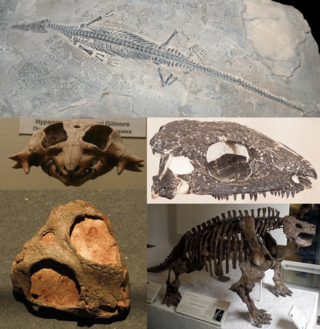
Parareptilia ("near-reptiles") is a subclass or clade of basal sauropsids/reptiles, typically considered the sister taxon to Eureptilia. Parareptiles first arose near the end of the Carboniferous period and achieved their highest diversity during the Permian period. Several ecological innovations were first accomplished by parareptiles among reptiles. These include the first reptiles to return to marine ecosystems (mesosaurs), the first bipedal reptiles, the first reptiles with advanced hearing systems, and the first large herbivorous reptiles. The only parareptiles to survive into the Triassic period were the procolophonoids, a group of small generalists, omnivores, and herbivores. The largest family of procolophonoids, the procolophonids, rediversified in the Triassic, but subsequently declined and became extinct by the end of the period.

Procolophonidae is an extinct family of small, lizard-like parareptiles known from the Late Permian to Late Triassic that were distributed across Pangaea, having been reported from Europe, North America, China, South Africa, South America, Antarctica and Australia. The most primitive procolophonids were likely insectiovous or omnivorous, more derived members of the clade developed bicusped molars, and were likely herbivorous feeding on high fiber vegetation or durophagous omnivores. Many members of the group are noted for spines projecting from the quadratojugal bone of the skull, which likely served a defensive purpose as well as possibly also for display. At least some taxa were likely fossorial burrowers. While diverse during the Early and Middle Triassic, they had very low diversity during the Late Triassic, and were extinct by the beginning of the Jurassic.
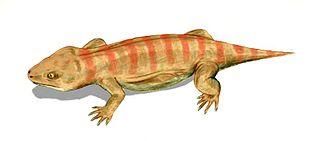
Procolophon is a genus of lizard-like procolophonid parareptiles that first appeared in the Early Triassic (Induan) of South Africa, Brazil, and Antarctica. It persisted through the Permian–Triassic extinction event, but went extinct in the beginning of the Early Middle Triassic. The type species is P. trigoniceps.

Sclerosaurus is an extinct genus of procolophonid parareptile known from the Early to Middle Triassic of Germany and Switzerland. It contains a single species, Sclerosaurus armatus. It was fairly small, about 30 cm long, distinguished from other known parareptiles by the possession of long, backwardly projecting spikes, rear lower jaw teeth with slightly imbricating crowns, and a narrow band of back armor comprising two or three rows of sculptured osteoderms on either side of the midline.
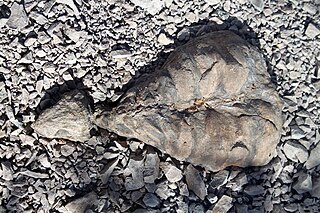
Eunotosaurus is an extinct genus of amniote, possibly a close relative of turtles. Eunotosaurus lived in the late Middle Permian and fossils can be found in the Karoo Supergroup of South Africa. Eunotosaurus resided in the swamps of southern Africa. Its ribs were wide and flat, forming broad plates similar to a primitive turtle shell, and the vertebrae were nearly identical to those of some turtles. Accordingly, it is often considered as a possible transitional fossil between turtles and their prehistoric ancestors. However, it is possible that these turtle-like features evolved independently of the same features in turtles, since other anatomical studies and phylogenetic analyses suggest that Eunotosaurus may instead have been a parareptile, an early-diverging neodiapsid unrelated to turtles, or a synapsid.
Phonodus is an extinct genus of procolophonid parareptile. It is known from a single skull found from the Early Triassic Katberg Formation in South Africa. It is the oldest known member of the subfamily Leptopleuroninae, and was likely the result of a procolophonid migration into the Karoo Basin from Laurasia after the Permo-Triassic extinction event. Because Phonodus had large maxillary teeth underneath a large antorbital buttress, and a lack of ventral temporal emargination along the side of the skull, it probably had a durophagous diet.

Sauropareion is an extinct genus of basal procolophonid parareptile from earliest Triassic deposits of Eastern Cape Province, South Africa. It is known from the holotype SAM PK-11192, skull and partial postcranium. It was collected by the late L. D. Boonstra in 1935 from Barendskraal in the Middelburg District and referred to the Lystrosaurus Assemblage Zone of the Beaufort Group. It was first named by Sean P. Modesto, Hans-Dieter Sues and Ross J. Damiani in 2001 and the type species is Sauropareion anoplus. The generic name means "lizard", sauros, and "cheek", pareion from Greek in reference to the lizard-like appearance of the temporal region. The specific name comes from the Greek word anoplos, meaning "without arms or armour".
Pintosaurus is an extinct genus of basal procolophonid parareptile from Late Triassic deposits of northeastern Uruguay. It is known from the holotype FC-DPV 1181, a partial skull. It was collected from the Buena Vista Formation of the Paraná Basin, in Colonia Orozco, Cerro Largo Department. It was first named by Graciela Piñeiro, Alejandra Rojas and Martín Ubilla in 2004 and the type species is Pintosaurus magnidentis. The generic name honours Dr. Iraja Damiani Pinto. The specific name means "with a large tooth" in Latin, a reference to the large palatal tooth pair.
Theledectes is an extinct genus of theledectine procolophonid parareptile from middle Triassic deposits of Free State Province, South Africa.The type species, Theledectes perforatus, is based on the holotype BP/1/4585, a flattened skull. This skull was collected by the South African palaeontologist, James W. Kitching from Hugoskop in the Rouxville District and referred to subzone B of the Cynognathus Assemblage Zone of the Burgersdorp Formation, Beaufort Group. The genus was first named by Sean P. Modesto and Ross J. Damiani in 2003. However, the species was initially assigned to the genus Thelegnathus by C.E. Gow in 1977, as the species Thelegnathus perforatus.
Phaanthosaurus is an extinct genus of basal procolophonid parareptile from early Triassic deposits of Nizhnii Novgorod, Russian Federation. It is known from the holotype PIN 1025/1, a mandible. It was collected from Vetluga River, Spasskoe village and referred to the Vokhmian terrestrial horizon of the Vokhma Formation. It was first named by P. K. Chudinov and B. P. Vjushkov in 1956 and the type species is Phaanthosaurus ignatjevi.

Lanthanosuchoidea is an extinct superfamily of ankyramorph parareptiles from the middle Pennsylvanian to the middle Guadalupian epoch of Europe, North America and Asia. It was named by the Russian paleontologist Ivachnenko in 1980, and it contains two families Acleistorhinidae and Lanthanosuchidae.
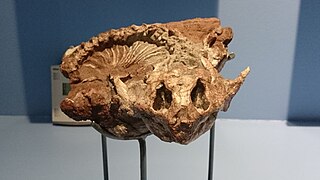
Teratophon is an extinct genus of procolophonine procolophonid parareptile from middle Triassic deposits of Free State Province, South Africa. It is known from the holotype BP/1/4299, a nearly complete skull. It was collected by the South African palaeontologist, James W. Kitching from Hugoskop in the Rouxville District and referred to subzone B of the Cynognathus Assemblage Zone of the Burgersdorp Formation, Beaufort Group. It was first named by Sean P. Modesto and Ross J. Damiani in 2003 and the type species is Teratophon spinigenis. It was first assigned to a species of Thelegnathus, Thelegnathus spinigenis.
Thelerpeton is an extinct genus of procolophonine procolophonid parareptile from middle Triassic deposits of Free State Province, South Africa. It is known from the holotype BP/1/4538, a nearly complete skull. It was collected by the South African palaeontologist, James W. Kitching from Hugoskop in the Rouxville District and referred to subzone B of the Cynognathus Assemblage Zone of the Burgersdorp Formation, Beaufort Group. It was first named by Sean P. Modesto and Ross J. Damiani in 2003 and the type species is Thelerpeton oppressus. It was first assigned to a species of Thelegnathus, Thelegnathus oppressus.

Procolophoninae is an extinct subfamily of procolophonid parareptiles from the late Early Triassic to the early Middle Triassic of Africa, Antarctica, Asia, Europe and South America. Currently, the oldest-known procolophonine is Procolophon from the earliest Olenekian stage.
Pentaedrusaurus is an extinct genus of procolophonid parareptile from the Early Triassic of China. It is one of the most basal members of the procolophonid subfamily Leptopleuroninae. The only known species of Pentaedrusaurus, P. ordosianus, was named in 1989 from the Heshanggou Formation.
Neoprocolophon is an extinct genus of procolophonid parareptile, known from the single species Neoprocolophon asiaticus from the Middle Triassic of China. It was named by Chinese paleontologist Yang Zhongjian in 1957 from the Ermaying Formation.
Scoloparia is an extinct genus of procolophonid parareptile from the Triassic of Canada. Fossils have been found in the Early Triassic to Norian-age Wolfville Formation in Nova Scotia, Canada. Like many Triassic procolophonids, Scoloparia has expanded molar-like teeth that indicate that the animal was likely herbivorous.

Kapes is an extinct genus of procolophonid parareptile from the Lower and Middle Triassic of the United Kingdom and Russia. It is a member of the subfamily Procolophoninae. The type species K. amaenus was named in 1975 from the banks of the Vychegda River in the Komi Republic of Russia. In 1983, a new species was brought into the genus, K. majmesculae. K. majmesculae was first named in 1968 as a member of the genus Tichvinskia. A third Russian species, K. serotinus, was named in 1991. In 2002, Kapes bentoni was named from the Middle Triassic Otter Sandstone Formation of Devon, England, extending the geographic range of Kapes. In the same paper, K. serotinus was synonymized with K. majmesculae and another Russian species was assigned to Kapes called K. komiensis. K. komiensis was first named in 1975 as a member of the genus Macrophon.
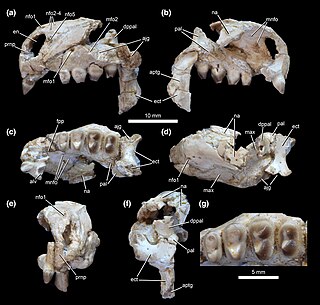
Hwiccewyrm is an extinct genus of leptopleuronine procolophonid parareptile from the Late Triassic Magnesian Conglomerate of England. The type, and currently only, species is H. trispiculum.
















